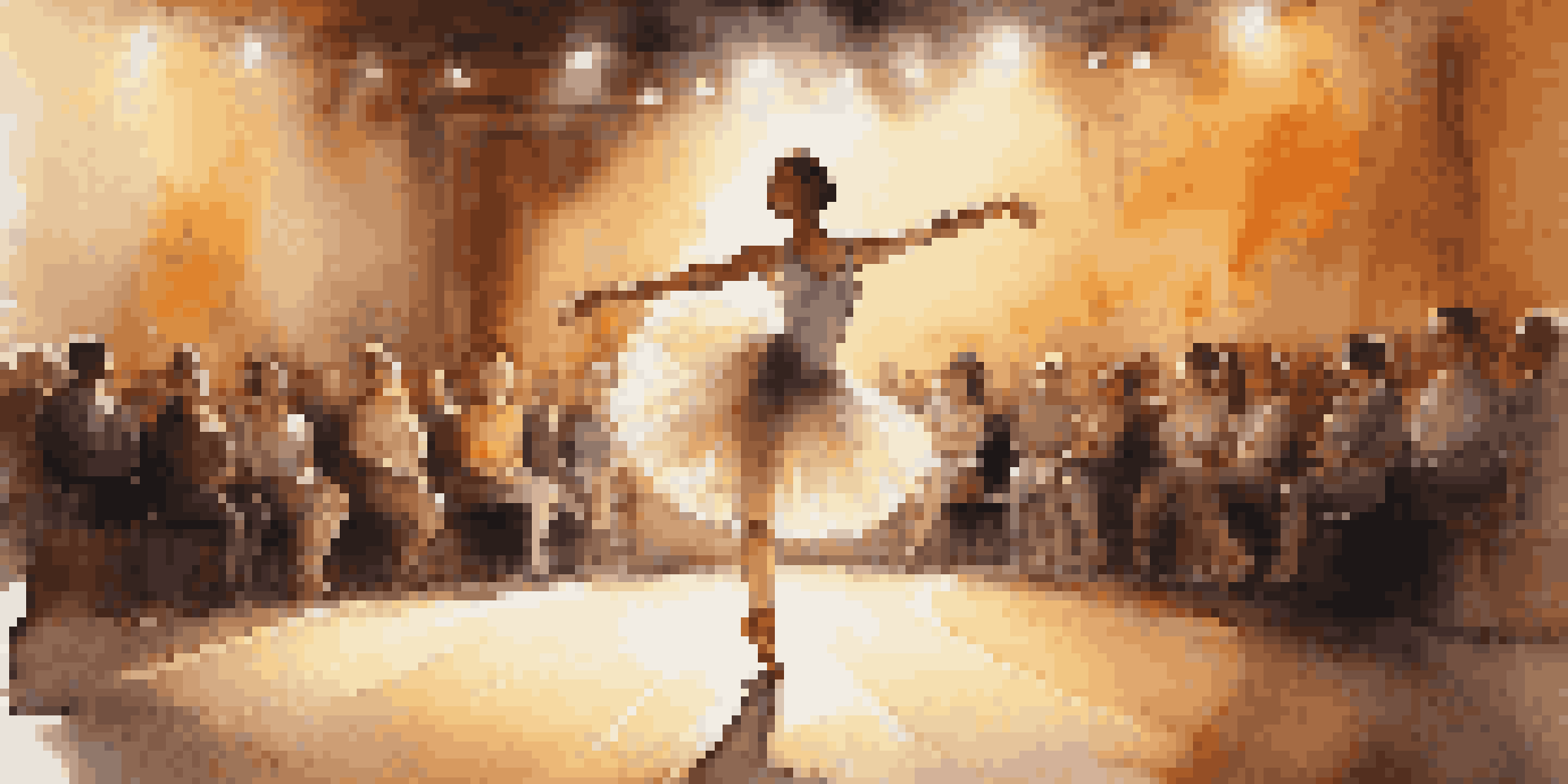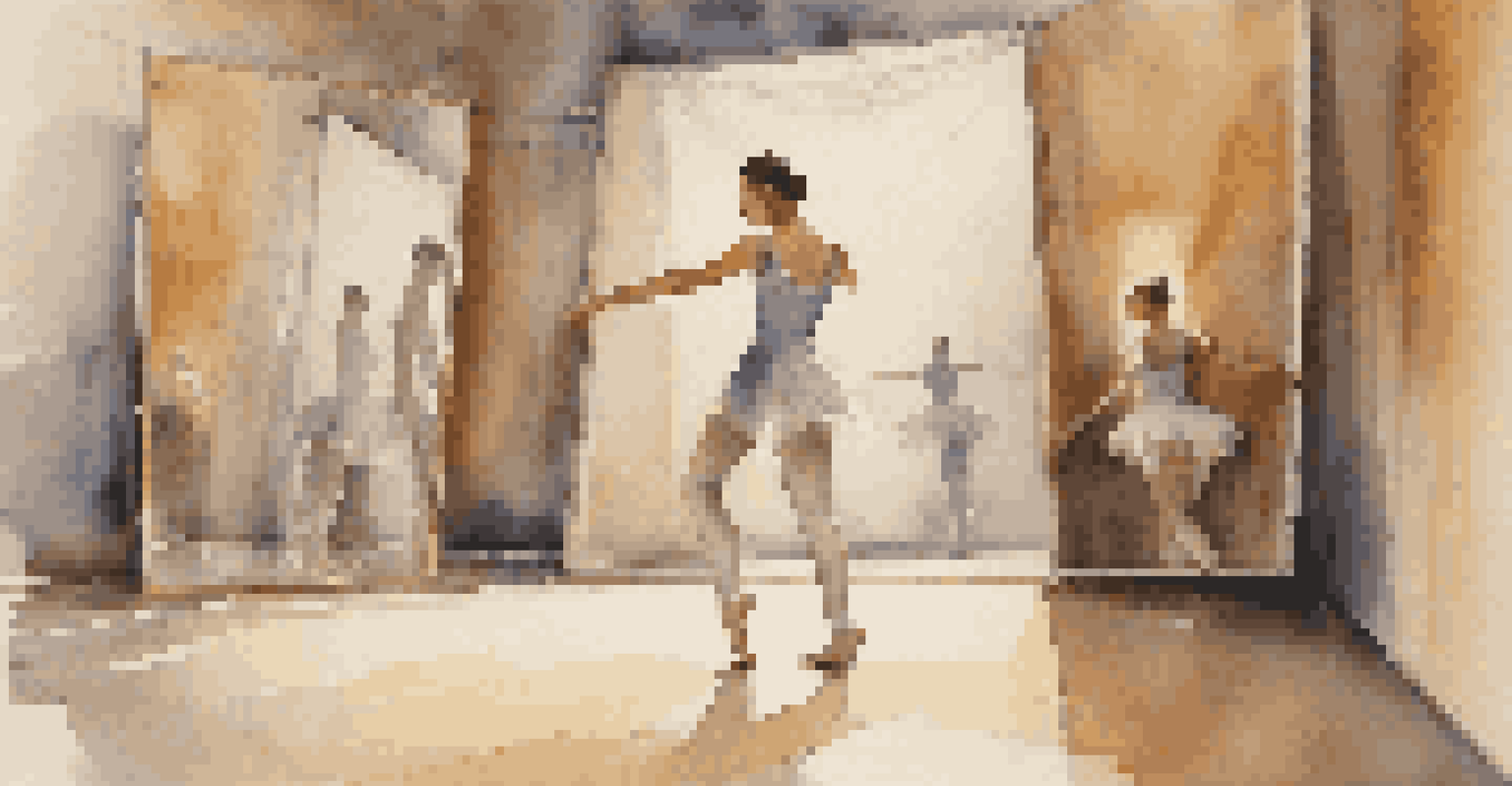The Effect of Audience Size on Dance Performance Anxiety

What is Dance Performance Anxiety (DPA)?
Dance Performance Anxiety (DPA) is a common experience among dancers, manifesting as nervousness or fear before or during a performance. This anxiety can stem from various factors, including self-doubt, fear of judgment, and concern over one's skill level. For many dancers, the size of the audience can significantly amplify these feelings, making it crucial to understand this relationship.
Anxiety is the handmaiden of creativity.
Imagine standing on stage, spotlight shining, with a sea of faces staring back at you. For some, this scenario can ignite excitement, while for others, it triggers overwhelming anxiety. The pressure to perform well can feel suffocating, and it's essential to unpack how audience size plays a role in this emotional cocktail.
Understanding DPA is the first step in addressing it. Dancers often find that their anxiety levels fluctuate based on who is watching, which can help them develop strategies to cope and perform better.
How Audience Size Influences Anxiety Levels
The size of the audience can fundamentally change a dancer's experience. A small crowd may feel intimate and supportive, creating an environment where dancers can thrive. Conversely, a large audience can amplify feelings of vulnerability and fear of scrutiny, leading to heightened anxiety.

Consider the difference between performing for a handful of friends versus a packed auditorium. The familiar faces of friends can provide encouragement, while a larger audience can feel more like a judgmental panel. This shift in dynamics can drastically affect a dancer's confidence and performance quality.
Understanding DPA is Crucial
Recognizing Dance Performance Anxiety (DPA) helps dancers develop coping strategies and improve their performance.
Understanding this relationship allows dancers and instructors to prepare mentally for different performance settings. By recognizing the potential impact of audience size, dancers can implement coping strategies to manage their anxiety better.
The Role of Preparation in Managing Anxiety
Preparation plays a crucial role in alleviating performance anxiety. Dancers who practice extensively and feel confident in their skills are often better equipped to handle the stress of performing for larger audiences. This preparation includes not just physical practice, but also mental rehearsal techniques.
The only thing we have to fear is fear itself.
For example, visualizing a successful performance can help dancers build confidence and reduce anxiety. By imagining themselves dancing confidently in front of an audience, they can create a mental framework that eases nerves when the moment arrives.
Additionally, creating a performance routine can help dancers feel more in control. This routine can involve warm-up exercises, breathing techniques, and positive affirmations to bolster self-assurance before stepping on stage.
Coping Strategies for Larger Audiences
When faced with the prospect of performing for a large audience, dancers can benefit from specific coping strategies. Techniques such as deep breathing, mindfulness, and grounding exercises can help reduce feelings of anxiety in the moments leading up to a performance. These practices allow dancers to center their thoughts and focus on their movements.
Another effective strategy is to reframe the performance mindset. Instead of viewing the audience as critics, dancers can focus on the joy of sharing their art. This shift in perspective can transform anxiety into excitement and anticipation.
Audience Size Affects Anxiety
The size of the audience can significantly influence a dancer's confidence and anxiety levels during a performance.
Moreover, connecting with fellow performers can provide a sense of camaraderie and support. Knowing that others share similar feelings can help normalize anxiety and create a more positive atmosphere.
The Impact of Audience Feedback on Performance
Audience feedback, whether verbal or non-verbal, can significantly impact a dancer's performance. Positive reactions, like applause or cheers, can boost confidence and diminish anxiety, while a lack of response may intensify self-doubt. Understanding this feedback dynamic is vital for dancers aiming to maintain composure.
Consider the difference between performing in front of an engaging audience versus one that appears indifferent. A supportive audience can create a feedback loop that enhances a dancer's performance, while a disengaged crowd can lead to increased anxiety and decreased motivation.
Dancers can learn to focus on the experience of performing rather than fixating on audience reactions. By doing so, they can cultivate resilience and adaptability, crucial traits for any performer.
Long-term Effects of Performance Anxiety
While some anxiety before performances is normal, chronic performance anxiety can have long-term implications for a dancer's career. It can lead to burnout, decreased enjoyment, and even a reluctance to perform altogether. Recognizing and addressing these feelings early on is essential for sustaining a healthy relationship with dance.
For instance, dancers who experience persistent anxiety may begin to associate performance with negativity, impacting their overall passion for dance. This shift can hinder their growth and enjoyment in the art form, making it crucial for them to seek support.
Preparation Mitigates Anxiety
Thorough preparation, including mental rehearsal and a performance routine, can alleviate anxiety and enhance performance quality.
Engaging with mental health professionals, joining support groups, or discussing experiences with peers can provide valuable insights and coping mechanisms. Addressing these issues proactively can help dancers maintain their love for performance.
Conclusion: Embracing the Journey
Navigating performance anxiety is a journey every dancer undertakes, especially when faced with varying audience sizes. By understanding the intricacies of how audience size impacts anxiety, dancers can develop practical strategies to enhance their performances. This journey is about finding balance and embracing the unique challenges each performance presents.
It's essential to remember that anxiety is a natural part of performing, and each dancer's experience is unique. By sharing stories and strategies, dancers can foster a supportive community that recognizes and validates these feelings.

Ultimately, embracing the journey of dance, with all its highs and lows, can lead to deeper growth and fulfillment. The stage is not just a place for performance; it’s an opportunity for connection, expression, and resilience.